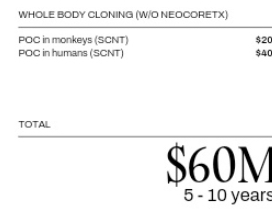LaraPo
#41
Scientists have created miniorgans from cells floating in the fluid that surrounds a fetus in the womb – an advance they believe could open up new areas of prenatal medicine.
4 Likes
Neo
#42
Hi Jay, would love to hear your thoughts on my two replies to your questions
Jay
#43
Neo, I have not looked at the links because of limited time, but your response otherwise sounds convincing.
1 Like
ng0rge
#44
Since I try to follow your lead, I changed my avatar (appropriate to my living in Mexico). Your new one is too dark (from “Dune”?). I liked “the Dude” better. Guess I can’t piss on your rug no more…

Jesus Quintana (John Turturro) from The Big Lebowski
3 Likes
Transplanting Whole Human Eyes To Restore Vision In Patients Who Are Blind Or Visually Impaired - Dr. Calvin Roberts, M.D. - Program Manager, Transplantation of Human Eye Allografts (THEA)
2 Likes
Coming soon. The published roadmap is an outline only. And this estimate is for a demonstration of certain basic tech/science (de-risking only) no scale-up. In the video we mention applying the “rule of pi at least once” ;
Is there a credible plan to solve aging in our lifetimes?
A plausible series of steps from where we are today, to a post-aging future?
We looked, but we couldn’t find one. So we decided to build one.
From this thread on X: https://x.com/LBF_org/status/1764754750694932483?s=20
4/ Stay Updated with our New Podcast! We will regularly update the roadmap as new projects, science & technology emerge. You can follow our process by listening to our expert interviews on the Longevity Acceleration Podcast:
3 Likes
Neo
#47

Wow, that is less than I would have thought money wise (I knew it could go fast technically as it is mostly just leveraging what Mother Nature has figured our already so much easier than other parts of generative medicine)
While the cost to get to full body transplant capabilities for your head are bigger in the table (but not bigger than for many single normal drugs), above would mean that you get
- as much young blood from your own identical dna as you want
- same re stem cells
- same re kidneys, liver, heart
- etc, etc, etc
That could alone give you a couple of decades (?) extra - during which time additional progress has been made…
Seems likes one of the highest potential things there is for material longevity…?
(Assuming bioethicists are brought in (should be ok) and society is ok with the “Frankenstein factor” (might make time, was similar for normal organ transplantation, IVF, etc)
3 Likes
What will you do about brain aging?
Or stress resilience? For example my grandmother she had a car accident at 95, nothing major, a young person would be kept for observation overnight if anything but in her case her organs started to shut down, in few days she was in complete organ failure and died.
It all looks super nice on paper, but technology won’t solve aging. Slow it down is a great possibility. Give you a decade or two more, maybe.
2 Likes
A_User
#49
You could get it in Próspera in the case it wouldn’t be okay but it would be much more expensive.
Neo
#50
Very good questions @scta123
I tried to provide some thoughts on that here: Regenerative Medicine, Growing New Organs, Etc - #29 by Neo
and also here: Regenerative Medicine, Growing New Organs, Etc - #28 by Neo
@scta123 What are your thoughts on those reflections? Would love to hear your perspective.
Neo
#51
I think it’s important to do via a path that will work with frameworks of developed world countries.
Used could be first done for more easy situation to evaluate: a person dying of organ impairment on the transplant waitlist. And so and so on.
But, yeah, perhaps someone will start in jurisdictions like you mentioned.
I will try to read your points and references and give you my perspective on that.
1 Like
Neo
#53
Thank you @scta123 , much appreciated!
As my sister-in-law is waiting for a kidney, this could be life-saving news. Now the question is how long until everyone is approved for one/can get one?
1 Like
For the first time, scientists are attempting to grow a new, miniature liver inside of a person. It sounds like science fiction; in fact, the idea was the plot of a Grey’s Anatomy episode that aired in 2018. Now, biotech company LyGenesis is trying to turn the concept into reality.
Today, LyGenesis announced that an initial volunteer has received an injection of donor cells to turn one of their lymph nodes into a second liver. The procedure was carried out in Houston on March 25 as part of a clinical trial that will test the experimental treatment in 12 adults with end-stage liver disease.
Full article: This Bag of Cells Could Grow New Livers Inside of People (Wired)
3 Likes
Neo
#61
Hi @scta123 - would really love to hear your perspectives here when you have some time!